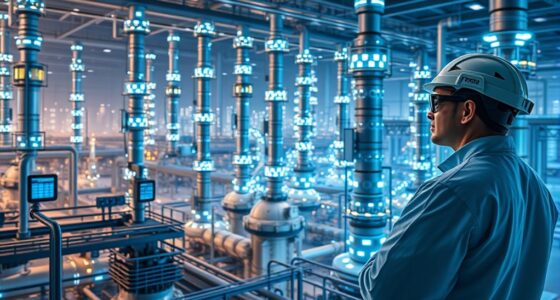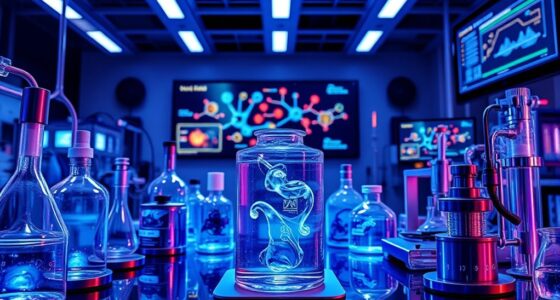Decentralized water treatment with modular chemistry allows you to manage water safety in remote areas effectively. You can customize systems with filtration and chemical disinfection tailored to community needs, making them scalable and easy to operate. These flexible solutions reduce dependence on external supplies, lowering costs and environmental impact. By adopting these modular systems, you gain control over water quality, promoting sustainability and resilience. Keep exploring to discover how these innovative approaches can empower your community.
Key Takeaways
- Modular treatment systems enable customizable water purification tailored to specific contamination levels in remote areas.
- Combining filtration and chemical disinfection ensures safe, reliable water without dependence on centralized infrastructure.
- Modular chemistry approaches facilitate easy system upgrades, expansion, and maintenance suited for evolving community needs.
- Decentralized solutions promote community ownership, reduce costs, and minimize environmental impact in resource-limited settings.
- Advanced membrane and chemical technologies ensure effective pathogen removal, supporting sustainable, long-term water safety.

Have you ever wondered how communities can effectively manage their water supply independently? In remote areas, this challenge becomes even more pressing. Traditional centralized systems often aren’t feasible, so innovative solutions are essential. One effective approach is decentralized water treatment, which allows communities to treat water locally using modular systems. These systems are adaptable, scalable, and tailored to specific needs, making them ideal for areas lacking extensive infrastructure.
Decentralized water treatment offers adaptable, scalable solutions for remote communities lacking extensive infrastructure.
A key component of these systems is innovative filtration, which removes particles, bacteria, and viruses from water sources. Advanced filtration methods, such as membrane filters or sand filters, guarantee that water is safe to drink without relying solely on chemical treatments. This reduces dependency on chemicals and minimizes environmental impact, making the process both sustainable and cost-effective. The efficiency of these filtration technologies is continuously improving, driven by advancements in membrane technology.
Alongside filtration, chemical disinfection plays a critical role in guaranteeing water safety. After the initial removal of contaminants, adding disinfectants like chlorine or ultraviolet (UV) light helps eliminate any remaining pathogens. Chemical disinfection is quick, reliable, and easy to implement in decentralized setups. It forms an essential barrier against waterborne diseases, which are a significant risk in underserved communities.
When combined with innovative filtration, chemical disinfection creates an all-encompassing treatment process that guarantees the water isn’t only clean but also safe for daily use. This integrated approach simplifies operation, requiring minimal technical expertise, which is fundamental in remote areas where specialized personnel are often unavailable.
The modular nature of decentralized systems means you can design them to fit the community’s specific needs and resources. For example, if water sources are heavily contaminated, you might prioritize more robust filtration units followed by chemical disinfection. Conversely, in areas with less contamination, smaller, less complex systems can suffice.
This flexibility allows communities to maintain control over their water quality without depending on external agencies or centralized infrastructure. Additionally, these systems can be upgraded or expanded as needed, providing a sustainable long-term solution that grows with the community.
Implementing decentralized water treatment with innovative filtration and chemical disinfection also offers economic benefits. It reduces transportation costs, lowers reliance on imported chemicals, and minimizes waste. Plus, it empowers communities to take ownership of their water management, fostering resilience and self-sufficiency.
Furthermore, integrating appropriate treatment methods based on scientific principles ensures the effectiveness and safety of water treatment processes. In essence, by embracing modular, localized treatment systems, you’re not just improving water quality—you’re building sustainable, autonomous communities capable of managing their resources effectively, even in the most remote settings.
Frequently Asked Questions
How Long Does Modular Water Treatment Equipment Typically Last?
When asking how long modular water treatment equipment lasts, consider durability factors like material quality, maintenance, and operating conditions.
Typically, these systems have a lifespan estimation of 10 to 15 years, but proper upkeep can extend their durability.
You should regularly inspect and service the equipment, as this helps guarantee ideal performance and longevity.
Ultimately, understanding these factors helps you maximize your investment and keep your water treatment reliable over time.
What Maintenance Skills Are Required for Decentralized Systems?
You’d think maintaining water systems is rocket science, but it’s just basic skills wrapped in a fancy name. With proper maintenance protocols, you’ll develop essential skills like filter replacement, system inspection, and chemical handling.
Ironically, the more you learn, the easier it gets. Staying proactive and trained guarantees your decentralized system runs smoothly, saving you time and headaches.
Are Modular Units Suitable for Emergency Disaster Relief?
You’ll find that modular units are highly suitable for emergency disaster relief because their modular scalability allows quick adaptation to varying water demands.
Their design facilitates rapid emergency deployment, ensuring water treatment can be established swiftly in crisis zones.
You can easily expand or modify these units as needed, making them a reliable, flexible solution for urgent situations where immediate access to clean water is critical.
How Do Modular Systems Handle Variable Water Quality?
When dealing with water quality fluctuations, modular systems excel through their adaptability. You can easily adjust treatment processes to match changing water conditions, ensuring consistent quality.
Modular adaptability means you can add or modify components as needed, providing a flexible response to variable water sources. This approach keeps your water safe and compliant, even when quality fluctuates unexpectedly.
Making these adjustments helps ensure that your water treatment remains effective under diverse and unpredictable water conditions.
What Are the Initial Costs Compared to Centralized Treatment?
When considering initial costs, decentralized systems usually require higher upfront investments compared to centralized treatment because of scaling challenges and the need for multiple smaller units.
However, these costs often balance out over time through reduced infrastructure expenses and easier maintenance.
You’ll find that modular systems are flexible and suited for remote areas, but you should carefully evaluate the initial costs versus long-term savings to make the best decision.
Conclusion
By embracing modular chemistry for decentralized water treatment, you open the door to more sustainable and accessible solutions, even in the most remote corners. This innovative approach gently shifts the traditional narrative, offering a subtle promise of cleaner water without the need for large-scale infrastructure. As you explore these options, you’re quietly contributing to a future where everyone can enjoy safe, reliable water, no matter where life takes them. Sometimes, the smallest changes lead to the greatest impact.









